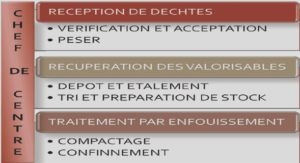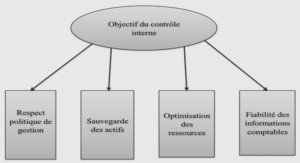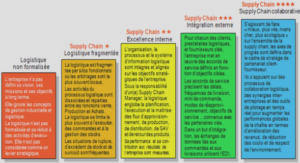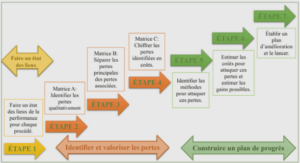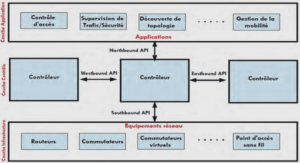SUR LA STABILITÉ DE CERTAINS SYSTÈMES COUPLÉS HYPERBOLIQUES-PARABOLIQUES
Stability of a nonlinear hyperbolic-parabolic coupled system
In this chapter we consider the study of a mechanical problem with thermal effects, on the one hand we have concentrated on the existence and uniqueness of the solutions and on the other hand we have shown the result of the stability of the problem, more precisely, this problem represents a von Karman system coupled with the thermal effect of the second sound where the heat flow is given by Cattaneo’s law. This system is given as follows wtt + γ1wt − d1 ux + 1 2 (wx) 2 wx x + d2wxxxx = 0, ω × R+, utt − d1 ux + 1 2 (wx) 2 x + δθx = 0, ω × R+, θt + qx + δutx = 0, ω × R+, qt + γ2q + θx = 0, ω × R+, (4.1) subject to the following boundary conditions u (0, t) = u (L, t) = w (0, t) = w (L, t) = 0, t ∈ R+, wx (0, t) = wx (L, t) = θ (0, t) = θ (L, t) = 0, t ∈ R+, (4.2) and the initial data u (·, 0) = u0, ut (·, 0) = u1, w (·, 0) = w0, x ∈ (0, L), wt (·, 0) = w1, q (·, 0) = q0, θ (·, 0) = θ0, x ∈ (0, L). (4.3) Here, the functions u(x, t), w(x, t), θ(x, t) and q(x, t) represent, respectively, the longitudinal, the transversal displacements, the temperature difference and the heat flux. The domain Ω is an interval (0, L) and the coefficients d1, d2, δ, γ1 and γ2 are positive constants which have a physical meaning. From the fourth equation of the system (4.1) and the boundary conditions, we easily verify that d dt R L 0 q (x, t) dx + γ2 R L 0 q (x, t) dx = 0. So, if we put q (x, t) = q (x, t) − R L 0 q0 (x) dx exp (−γ2t), then, by simple substitution, we check that (w, u, θ, q) satisfies (4.1) and more importantly we have R L 0 q (x, t) dx = 0, ∀t ≥ 0, 47 4. Stability of a nonlinear hyperbolic-parabolic coupled system which justified the use of the inequality of Poincare for ´ q. From now on, we work with q but write q for simplicity. This chapter has been inspired by the work [100], the first result is the following existence and uniqueness theorem Theorem 8. Let (w, ϕ, u, ψ, θ, q) T ∈ H. For any initial condition U0 ∈ H, there exists a unique solution for the problem (4.7) such that U ∈ C ([0, ∞), H). Moreover, if U0 ∈ D (A). Then, we have U ∈ C ([0, ∞), D (A)) ∩ C 1 ([0, ∞), H). We note that based on the semigroup approach our problem can be represented as a semilinear Cauchy problem which is given by Ut = AU + F (U), t > 0, U (0) = (w0, w1, u0, u1, θ0, q0), (4.4) Then, we can use the semigroup theory for the proof of the above result. Now, we define the energy functional by E (t) = 1 2 » kwtk 2 L2 + kutk 2 L2 + kθk 2 L2 + kqk 2 L2 + d2 kwxxk 2 L2 + d1 ux + 1 2 (wx) 2 2 L2 # . We give the following stability result. Theorem 9. Let (u, w, θ, q) be a solution of (4.1)-(4.3) where the initial data are given in H. Then, the energy E(t) satisfies E(t) ≤ kE(0)e −ξt , ∀t ≥ 0 (4.5) where k and ξ are two positive constants. By using the multiplier method, we prove that the dissipation induced by the heat effects of second sound is strong enough to stabilize system (4.1) in the presence of a frictional damping in the first equation of the system.
Preliminaries
Earlier results
In this section, we will shed light on the most important studies that dealt with the study of nonlinear dynamic elastic systems presented by von K´arm´an’s equations. We can say that the nonlinearity contained in the system comes from the modeling that depends on the theories of oscillation. Moreover, in the following works [66,101–104], the stability of some systems has been demonstrated, through which we find that there is a correlation between the results of this stability and the effects related to damping on the one hand, as well as temperature on the other hand. Lagnese et al. in paper [105], addressed the problems of existence, uniqueness, and the behavior of solution over time that some effects of damping are being considered, in addition to some other important characteristics, see e.g., [106], and references therein. Benabdallah and Teniou [65] proposed a new model in which a strong coupling of the system was imposed with two thermal equations: one for the longitudinal displacement and the other for the transversal displacement. As a result, the authors have shown that the system is exponentially stable. In paper [107] Djebabla and Tatar proposed a one-dimensional von Karman in which the coupling with the thermal effects is on the longitudinal displacement, where the heat equation according to Green-Naghdi’s theory, see references [36,37,108]. Similarly to the previous mention work, the authors have shown that the system is exponentially stable.
Chapter plan
This chapter is organized as follows. In Section (4.3) we state and show the well posedness of the system. In Section (4.4), we establish our stability results. 4.2 Preliminaries We introduce the following spaces L 2 ∗ (0, L) = v ∈ L 2 (0, L) : Z L 0 v dx = 0 , and H1 ∗ (0, L) = H1 (0, L) ∩ L 2 ∗ (0, L). Also, we give the Hilbert space H := H2 0 (0, L) × L 2 (0, L) × H1 0 (0, L) × L 2 (0, L) × L 2 (0, L) × L 2 ∗ (0, L), 49 4. Stability of a nonlinear hyperbolic-parabolic coupled system the space is equipped with the following inner product D U,Ue E H = Z L 0 ϕϕdx e + Z L 0 ψψdx e + Z L 0 θθdx e + Z L 0 qqdx e + d2 Z L 0 wxxwexxdx + d1 Z L 0 uxuexdx, (4.6) where U = (w, ϕ, u, ψ, θ, q) T ∈ H and U˜ = ( ˜w, ϕ, ˜ u, ˜ ψ, ˜ ˜θ, q˜) T ∈ H. 4.3 Existence and uniqueness In this section, we prove the existence, uniqueness, and smoothness of solution of problem (4.1)-(4.3) using the semigroup theory, see e.g., [99]. In this direction our main result is given by the following theorem. Theorem 10. Let (w, ϕ, u, ψ, θ, q) T ∈ H. For any initial condition U0 ∈ H, there exists a unique solution for the problem (4.7) such that U ∈ C ([0, ∞), H). Moreover, if U0 ∈ D (A). Then, we have U ∈ C ([0, ∞), D (A)) ∩ C 1 ([0, ∞), H). 4.3.1 The semigroup approach We introduce two new dependent variables ϕ = wt , and ψ = ut . Then, system (4.1)-(4.3) takes the form of an abstract first-order evolutionary problem Ut = AU + F (U), t > 0, U (0) = (w0, w1, u0, u1, θ0, q0), (4.7) 50 4.3 Existence and uniqueness where U = (w, wt , u, ut , θ, q) T and the linear operator A is defined as follows A = 0 I 0 0 0 0 −d2∂ 4 x −γ1I 0 0 0 0 0 0 0 I 0 0 0 0 d1∂ 2 x −δ∂x 0 0 0 0 0 −δ∂x 0 −∂x 0 0 0 0 −∂x −γ2I , and F (U) = 0 d1 hux + 1 2 (wx) 2 wx i x 0 d1 2 (wx) 2 x 0 0 . It is clear that F (U) is a continuous and uniformly Lipschitz operator. The domain of A is given by D(A) = U ∈ H/ w ∈ H4 (0, L) ∩ H2 0 (0, L), u ∈ H2 (0, L) ∩ H1 0 (0, L) θ ∈ H1 0 (0, L), q ∈ H1 ∗ (0, L), ϕ ∈ H2 0 (0, L), ψ ∈ H1 0 (0, L) 4.3.2 Proof of Theorem (10) Proof. First, the domain of A is dense in H. Next, we show that the operator A generates a C0-semigroup in H. For this step, we prove that the operator A is dissipative. Let define the vector U = (w, ϕ, u, ψ, θ, q) T . Then, we have AU = ϕ −γ1ϕ − d2wxxxx ψ d1uxx − δθx −qx − δψx −γ2q − θx , 51 4. Stability of a nonlinear hyperbolic-parabolic coupled system it is straightforward to verify that, for any U ∈ D(A) hAU, UiH = Z L 0
1 Introduction |


